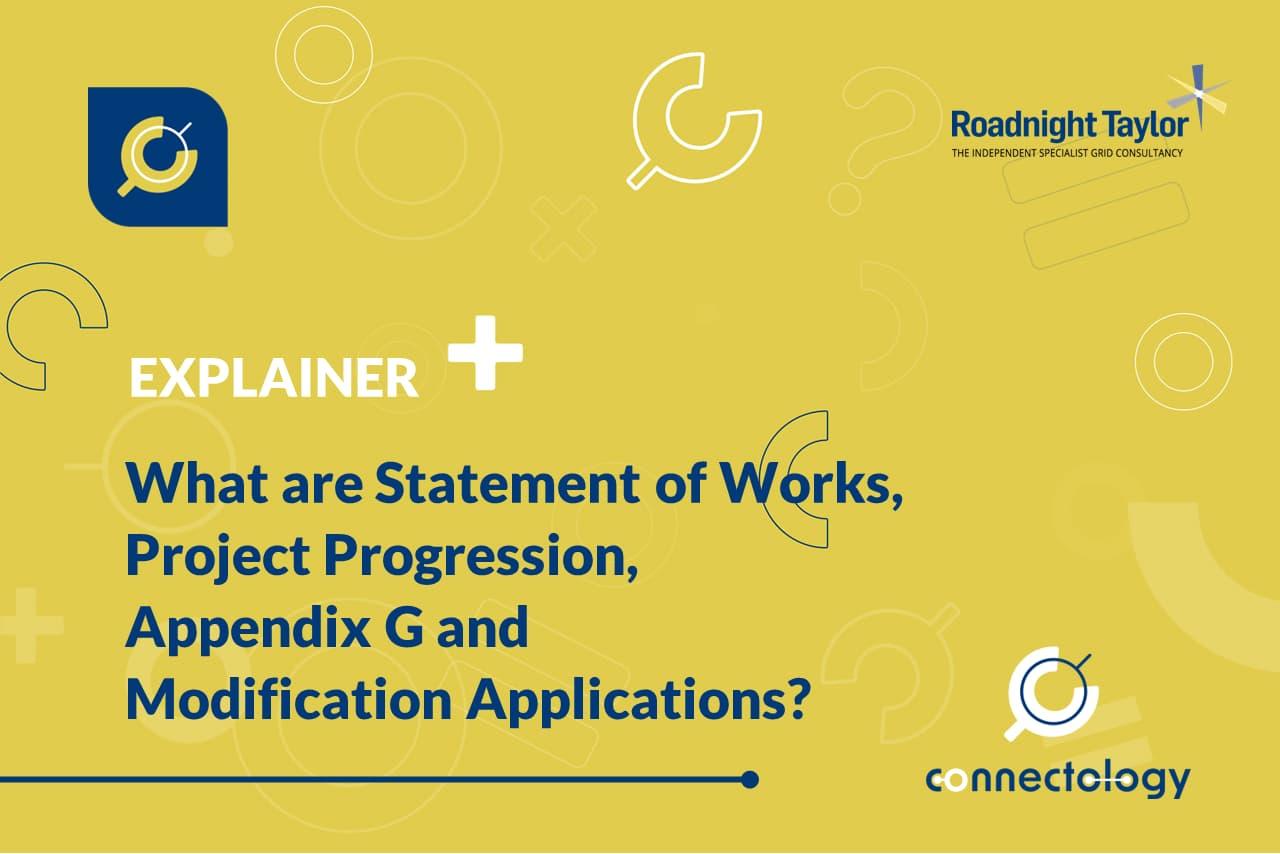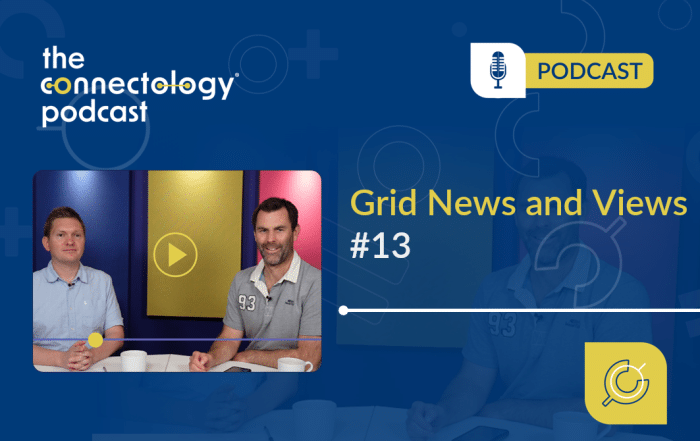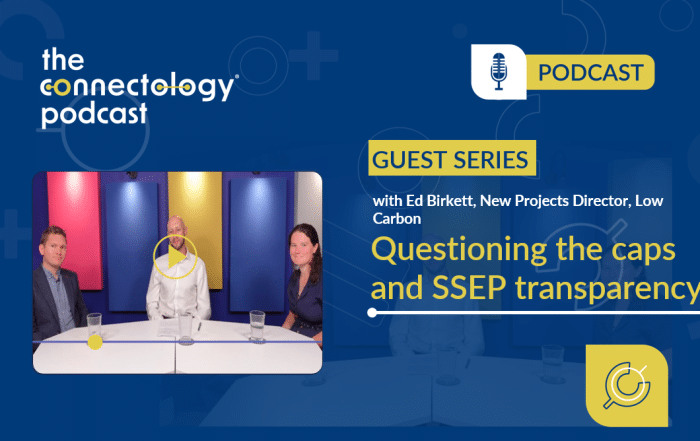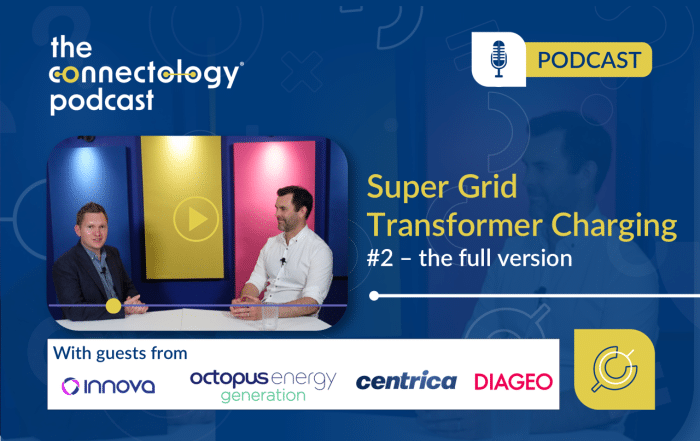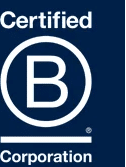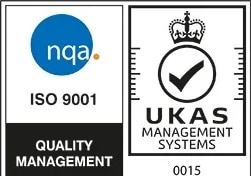What are Statement of Works, Project Progression, Appendix G and Modification Applications?
Statement of Works, Project Progression, Appendix G and Modification Applications are all terms relating to the way Distribution Network Operators (DNOs) inform National Energy System Operator (NESO) about generators connecting to the distribution network. Here we explain the terms in detail.
Article by Pete Aston – acknowledged expert in networks
Pete joined Roadnight Taylor from Western Power Distribution, the UK’s largest DNO, where he was Primary System Design Manager. He led a team of sixty responsible for all connections to the extra high voltage network WP, as well as leading WPD’s interaction with National Grid (NGET and NESO) at the transmission/distribution boundary.
First written: 01 November, 2022. Updated: 13 May, 2025.

Developers connecting generation schemes into the GB distribution network can no longer escape hearing about and being involved in Statement of Works and Project Progressions – but what are they and what is the difference? And what are the implications for new generation connections?
Statement of Works and Project Progression are the way Distribution Network Operators (DNOs) inform National Energy System Operator (NESO) about generators connecting to the distribution network. One or two generators connecting at distribution level would have very little impact on the transmission network. But hundreds and hundreds of generators connecting at distribution (which is what is happening), will have a big impact at transmission level. This is why NESO needs to know what is going on and needs some control over the process.
There are a number of terms which often get used interchangeably in relation to Statement of Works and Project Progressions, which can lead to confusion, so these terms are explained below.
What is Statement of Works?
Statement of Works (SoW) is an initial communication between a DNO and NESO, which a DNO uses to inform NESO about the potential connection of a single generator. NESO has 28 days to respond to the DNO and let them know that there are either no constraints on the transmission network, or that there are (or might be) transmission constraints. If there are no transmission constraints identified, then the DNO does not need to do anything else and can proceed to connect the generator. When transmission constraints are identified, the DNO is required to submit a Project Progression.
The threshold for being part of a Project Progression is 5MW or above in England and Wales, but lower in Scotland, where the transmission network has more constraints. DNOs have interpreted this limit differently, with some viewing it as export capacity, and some as installed capacity.
This Statement of Works step has a small charge (currently up to £3,800), but can be skipped if a DNO knows that there are already transmission constraints. Due to the large volume of generation in the contracted queue across the country, there is virtually nowhere where there are no transmission constraints. So, most DNOs will skip this step and go straight to Project Progression.
The phrase ‘Statement of Works’ is often used, colloquially, as a catch-all term to describe the general process by which a DNO will communicate generation connections to NESO.
What is Appendix G?
Appendix G (sometimes called the Transmission Impact Assessment) is a process which enables DNOs to notify NESO of newly accepted generation offers monthly. It was introduced by NESO and the DNOs in 2014/15 due to the volume of generation connecting across the country. It reduces the time spent notifying each individual generator under the Statement of Works process. With the Appendix G process, a DNO is given a Materiality Headroom for each Grid Supply Point (GSP). Provided that the headroom is not exceeded, the DNO can expect to get the Appendix G signed off each month.
The same 5MW threshold applies in England and Wales for inclusion in Appendix G.
When the Appendix G headroom has been exceeded, a DNO needs to submit a Project Progression to NESO. This Project Progression is essentially the same as that following a Statement of Works, but usually contains multiple generators.
For the geekier among you, Appendix G is a schedule (appendix) to the Bilateral Connection Agreement (BCA) that exists between NESO and a DNO for each GSP.
What is Project Progression?
Project Progression (PP) is the data and information a DNO submits to the NESO following a SoW, or the exceedance of headroom in an Appendix G. This is essentially a lot of data tables, showing NESO where in the DNO’s network the generators will connect, and the characteristics of the generators. It can be quite a lot of work for a DNO to pull together all the relevant information, and NESO can be quite strict in determining whether a PP is technically competent or not.
There is nothing governing how fast a DNO needs to submit a PP to NESO, and this has proved to be disastrous to many customers, with some DNOs inappropriately delaying the submission of a PP for as long as one and a half years. Once the PP has been clock-started by NESO (which means payment has been made and the data has been signed off as technically competent), NESO has three months to issue a Modification Offer to the DNO. The DNO then has three months in which to communicate the details of the Modification Offer to the generation customers who triggered it, and get the customers to sign a variation to their offer (if needed), before the DNO accepts the Modification Offer.
PPs can ‘stack up’, where a DNO has to wait for the outcome of one PP before they can submit the next one for the next batch of customers.
A PP can cost up to about £20k, and this charge is usually split between the number of customers included as part of the submission.
The outcome of a PP can be a requirement to wait for and/or pay towards transmission reinforcement, and can have a make-or-break effect on a generation scheme. Due to the timescales involved, a customer can expect to wait at least 12-18 months from submitting their application to the DNO to knowing the outcome of the PP process.
What is a Modification Application?
A Modification Application, or Mod App as they are more commonly referred to, is the process by which a transmission connectee applies to NESO to change their connection. This could be a transmission-scale generation customer looking to increase or decrease their Transmission Entry Capacity (TEC), or a DNO requesting to add a new super-grid transformer (SGT). They can cost up to about £145k, depending on where in the country the site is and the capacity of the connection.
In the context of generation applications, a DNO might need to make a Mod App to NESO for various reasons. The first time an Appendix G is created at a GSP, NESO normally insists on a Mod App being submitted. There can be other scenarios as well, such as when generation connections have triggered fault level upgrade works, or where there are proposed changes to network running arrangements. DNOs may or may not choose to pass the Mod App fee onto customers.
The phrase Mod App is often used interchangeably (mistakenly) with Project Progression. They are distinct processes, but the data transferred from the DNO to NESO and the application forms used are actually quite similar.
What are the implications for your generation connection?
As mentioned above, the decision for a DNO to put a site through the transmission assessment process is one of the biggest for a connection. A site that has to go through this process can be hit with massive delays and costs. And this all comes down to this 5MW threshold and how it is applied.
For sites that are definitely above the 5MW, the administration of the process by both the DNO and NESO can have a significant bearing on the outcome. Delays can be compounded by direct applications to connect to the transmission network jumping ahead of distribution customers in the queue.
Connections Reform
The Connections Reform process, which is being rolled out in 2025, is going to completely change the way applications are made to the transmission network. As such, some of the processes above will change from 2026 onwards.
How Roadnight Taylor can help you
We have helped many clients navigate this complex process and are in a very good position to advise you on strategies to minimise risk from the transmission assessment process. Whilst we can’t change the process (although we do regularly lobby the DNOs, NESO, Ofgem and others for change), we will make it work as best we can for your site.

